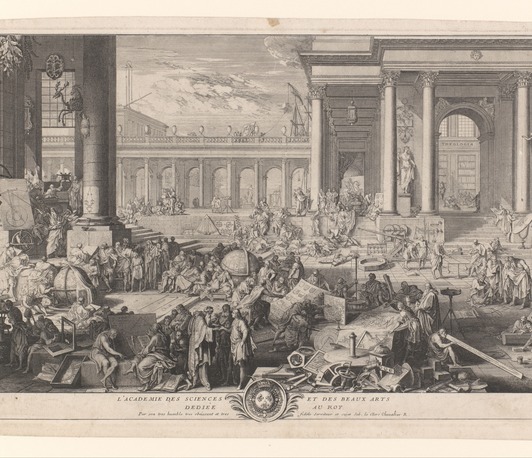Images and Institutions: The Visual Culture of Early Modern Scientific Societies
- Beginn: 14.09.2022
- Ende: 16.09.2022
- Vortragende(r): Conference
- Ort: Accademia dei Lincei, Royal Netherlands Institute in Rome (KNIR) and Bibliotheca Hertziana
- Kontakt: boehm@biblhertz.it

During this symposium
we will study the diverse ways in which images were used in the production and
dissemination of knowledge in early modern scientific societies such as the Accademia
dei Lincei, the Accademia del Cimento, and the Académie Royale des Sciences. Central
questions include: What common visual practices were shared among these institutions,
and importantly, where did they diverge? How did differing national artistic
contexts impact the visual culture of scientific institutions? And how did
these relationships shift over time with new enlightenment societies founded in
the 18th century? By comparing these institutions, we will explore the ways in
which images and image-making practices were integral to the advancement of
early modern collaborative science.
Program
If you are interested in attending any of the sessions in person in Rome, please contact secretary@knir.it as seating is limited. Sachiko Kusukawa's keynote lecture will be open to the public to attend, both in person and on zoom, but registration is required. To register please contact secretary@knir.it
Day 1 (14 September 2022) Accademia dei Lincei
14:00–14:30 Welcome
and Introduction (Katherine Reinhart and Matthijs Jonker)
Session 1. The Visual Strategies of the Early Accademia dei Lincei
Chair: Lucia Tongiorgi Tomasi (Accademia dei
Lincei)
14:30–15:00 paper 1. Irene Baldriga
Ut pictura manifestat: Iconographic Patterns and Documentation “After Reality” in the Visual Imagery of the First
Accademia dei Lincei
15:00–15:30 paper 2. Matthijs Jonker
Understanding the Exotic: Original and
Copied Images in the Production of the Tesoro messicano
15:30–16:00 Discussion
16:00–16:45 Break and time to see
the small exhibit in the Lincean archive
Session 2. Understanding other Cultures Through the Circulation of
Images
Chair: TBC
16:45-17:15 paper 3. Angelo Cattaneo
The “Armazém da
[Casa] Índia”
17:15–17:45 paper
4. Federica Favino
Structure and Iconography of the Ancient Triremes on the Trajan Column
17:45–18:15 paper
5. Aleksander Musiał
Tracing Vapours: António Nunes Ribeiro Sanches’s Treatise on Russian baths (1771-9) between Paris and Saint
Petersburg
18:15–19:00 Discussion
Day 2 (15 September 2022) Royal Netherlands Institute in Rome (KNIR)
Session 3. The Visual Strategies of Institutional Journals in the 18th Century
Chair: TBC
09:00–09:30 paper 6. Simon Rebohm
Between
Epistemology and Practice: Images in the Ephemerides of the Leopoldina
09:30–10:00 paper 7. Alicia Hughes
Image-making
in The Society of Physicians in London and the Medical Observations and Inquiries
journal (1754– 1784)
10:00–10:30 Discussion
10:30–11:00 Break
Session 4. Old Theories and New Instruments: Microscopy in Rome and London
Chair: Sietske Fransen (Bibliotheca Hertziana - Max Planck Institute for Art History)
11:00–11.30
paper 8. Ellen Pater
Through Buonanni’s Lens: Observing and
Representing Spontaneous Generation at the Collegio
Romano
11:30–12:00 paper 9. Xinyi Wen
Between
Internal and External: The Doctrine of Signatures and Visual Culture in Early
Royal Society
12:00–12:30 Discussion
12:00– 14:00 Lunch Break
Session 5. The Visual Strategies of the Accademia del Cimento
Chair: TBC
14:00–14:30
paper 10. Giulia Giannini
Making
the Invisible Visible: Images and Communication of Science at the
Accademia del Cimento
14:30–15:00
paper 11. Stefano Gulizia
Image-Making in the Cimento’s
Network: Expertise more geometrico in
Borelli, Steno, and Malpighi
15:00–15:30
paper 12. Eva Struhal
Virtual Witnessing: Illustrations and Mental Images in the Saggi della naturale
Esperienze
15:30–16:00 Discussion
16:00–17:00 Break
Keynote lecture (hybrid)
Chair: Florike Egmond (Leiden University)
17:00–18:30
paper 13. Sachiko Kusukawa
Early Modern Scientific Institutions and
Their Images
Day 3 (16 September 2022) Bibliotheca Hertziana
Session 6. The Visual Strategies of the Académie Royale des Sciences and
other French Institutions
Chair: TBC
09:00–09:30
paper 14. Katherine Reinhart
Science & Statecraft:
On the Epistemic and Political Functions of Images in the
Académie Royale des Sciences
09:30–10:00
paper 15. Antoine Gallay
The Value of Accuracy: How Savants
Supervised Draughtsmen and Corrected Pictures in the Early Académie Royale des
Sciences
10:00–10:30 Discussion
10:30–11:00 Break
11:00–11:30
paper 16. Carole Nataf
Picturing shells from Senegal: Visual Competition at the Académie des Sciences, the Jardin du roi and
Parisian curieux circles in the Year 1757
11:30–12:00
paper 17. Leendert van der Miesen
Images and Their Detractors
at the Prize Contests of the Bordeaux Academy of
Sciences
12:00–12:30 Discussion
12:30–13:30 Lunch (provided by Bibliotheca Hertziana, for invited
speakers only)
Session 7. Artistic and Scientific Exchange within Early Modern
Institutions
Chair: TBC
13:30–14:00 paper 18. Sophie-Luise Mävers
Crossing Institutional Boundaries? Artistic Reflections on the Interdependencies of Academies of Sciences and Arts
in Late 17th and 18th Century Europe
14:00–14:30 paper 19. Immacolata Iaccarino
Gelati’s Intellectual Circle: the Epistemic Interaction and the Figurative Program of Ottavio Scarlattini’s L’huomo,
e sue parti figurato (1684)
14:30–15:00 Discussion
15:00–15:30 Break
15:30–16:00
paper 20. Ruth Sargent Noyes
A case study in a previously
unidentified state of Mattheus Greuter’s Melissographia
16:00–16:30
paper 21. Eric Jorink
Teyler’s Foundation of Haarlem (1778): Between Art, Science, and Religion
16:30–17:00 Discussion
17:00–17:15 Break
17:15–18:00 Final Discussion
Scientific organization: Katherine Reinhart (Binghamton University), Matthijs Jonker (Royal Netherlands Institute in Rome, KNIR), Irene Baldriga (Sapienza, Università di Roma), Sietske Fransen (Bibliotheca Hertziana – Max Planck Institute for Art History)